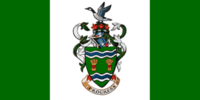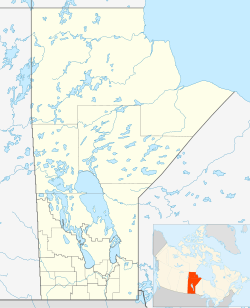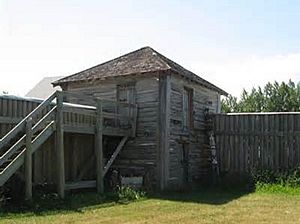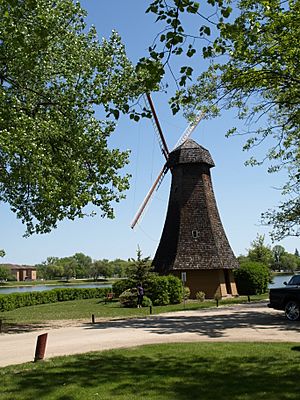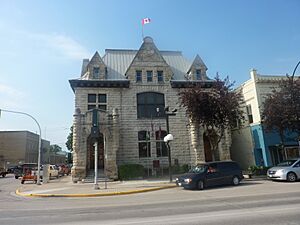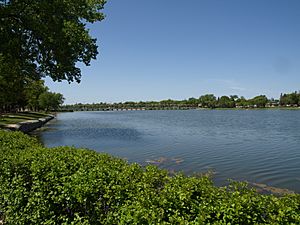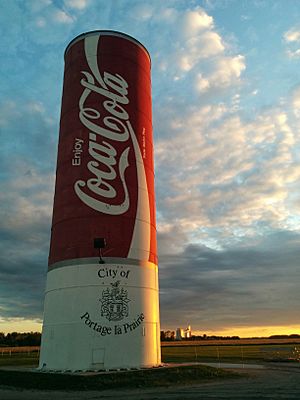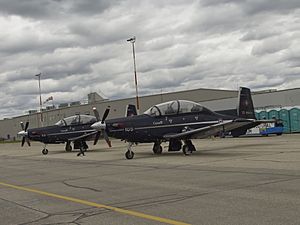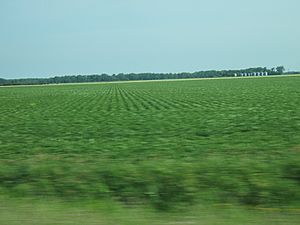Portage la Prairie facts for kids
Quick facts for kids
Portage la Prairie
|
||
|---|---|---|
|
City
|
||
| City of Portage la Prairie | ||

Clockwise from top left to centre: City Welcome Sign, Aerial View of Portage la Prairie, World's Largest Coca-Cola Can, Birds' Eye View of Crescent Lake and Island Park, Waterfront Active Transport Route, Island Park, City Hall
|
||
|
||
| Nickname(s):
Portage, P. la P., Plaptown
|
||
| Motto(s):
Progress
|
||

City boundaries
|
||
| Country | Canada | |
| Province | Manitoba | |
| Region | Central Plains | |
| Established | 1738 (Fort La Reine) | |
| Settled | 1851 (village) | |
| Incorporated | 1880 (town) 1907 (city) |
|
| Government | ||
| • Type | Mayor–council government | |
| Area | ||
| • Land | 24.72 km2 (9.54 sq mi) | |
| • Metro | 2,029.94 km2 (783.76 sq mi) | |
| Elevation | 261 m (856 ft) | |
| Population
(2021)
|
||
| • City | 13,270 (5th) | |
| • Density | 536.8/km2 (1,390/sq mi) | |
| • Metro density | 10.1/km2 (26/sq mi) | |
| Demonym(s) | Portager, Portage la Prairian | |
| Time zone | UTC-6 (Central Time zone) | |
| • Summer (DST) | UTC-5 | |
| Forward sortation area |
R1N
|
|
| Area code(s) | 204/431 | |
| Website | www.city.portage-la-prairie.mb.ca | |
Portage la Prairie is a small city in the Central Plains Region of Manitoba, Canada. In 2016, about 13,300 people lived there. The city covers an area of about 24.68 square kilometers.
Portage la Prairie is located about 75 kilometers west of Winnipeg. It sits right along the Trans-Canada Highway. This means it is exactly halfway between the provinces of Saskatchewan and Ontario.
The city is built on the Assiniboine River. This river used to flood the town often. To stop this, a special channel called the Portage Diversion was built. It sends floodwaters north to Lake Manitoba. The city is surrounded by the larger Rural Municipality of Portage la Prairie.
Environment Canada says that Portage la Prairie gets the most sunny days in Canada during the warm months. It is also the main office for the Dakota Tipi First Nations reserve.
Contents
History of Portage la Prairie
Long before European settlers arrived, Indigenous peoples, known as Plains Indians, lived in this area. In September 1738, the fur trade was growing in Western Canada. A French Canadian explorer named Pierre Gaultier de Varennes, sieur de La Vérendrye built Fort La Reine.
This fort was north of the Assiniboine River. It was a place for trading furs. It also served as a base for explorers to discover more of Manitoba and western North America.
In 1851, Archdeacon William Cochrane and other settlers bought land from the local Indigenous people. This land was near what is now Crescent Lake. Soon, a school was built as more settlers came from Eastern Canada. A church, St. Mary's La Prairie, followed in 1854. Many local businesses also started as the community grew.
The rich soil of the Portage la Prairie area was discovered in the 1850s. This led to the village's future in farming. Archdeacon Cochrane encouraged people to grow crops to feed the growing population. A local government was formed in 1857. By the 1860s, there were sixty homes in the community.
The 1870s saw fast growth. Many more settlers moved to Portage, starting farms and opening new businesses. The village had a flour mill, a local newspaper, and a community fair. From the 1870s to the 1880s, the population grew from 300 to 3,000 people.
Goods were moved by ox-cart and steamboat. Then, the Canadian Pacific Railway (CPR) arrived in 1881. That same year, Portage became a town. Thomas Collins was the first mayor. In 1907, Portage became a city. Since then, it has grown steadily. It is now a center for farming, shopping, manufacturing, and transportation in central Manitoba.
During World War II, the Royal Canadian Air Force built Canadian Forces Base Portage la Prairie. This base supported the British Commonwealth Air Training Plan. It helped train pilots from many countries. The name "Portage la Prairie" comes from the French word portage. This means carrying a canoe overland between waterways. Here, the "portage" was between the Assiniboine River and Lake Manitoba, across la prairie (the prairie).
Geography and Landscape
Portage la Prairie became an important transportation hub. This is because it is close to the river. Later, the main lines of Canada's national railways passed through the city. The CPR and Canadian National Railways (CNR) cross paths in Portage. This is one of the few places in Canada where both railways meet.
About 72 trains pass through the city every day. This makes Portage la Prairie a great spot for people who love watching trains. The Trans-Canada Highway also runs past the city. This brings business when travelers stop in Portage.
The land around Portage la Prairie is very fertile. It has rich, clay-loam soils full of nutrients. Because of this, Portage la Prairie is a major farming center in Manitoba and Canada. The land is known for growing many vegetables, berries, grains, and lentils.
The city has a strong tree-planting program. It is known for its many old trees. Some of the largest cottonwood trees in Canada grow along Saskatchewan Avenue. This is the main street. Many other trees like Manitoba maple, bur oak, and green ash are also found throughout the city.
Portage la Prairie is the hometown of former Prime Minister of Canada Arthur Meighen. A school and a street are named after him.
Climate
Environment Canada states that Portage la Prairie has the most sunny days during the warm months in Canada. The city has a humid continental climate. This means it has warm summers and very cold, dry winters. The highest temperature ever recorded was 41.1°C on July 11, 1936. The coldest temperature ever recorded was -44.0°C on February 2, 1996.
Population and People
| Historical populations | ||
|---|---|---|
| Year | Pop. | ±% |
| 1891 | 3,363 | — |
| 1901 | 3,901 | +16.0% |
| 1911 | 5,892 | +51.0% |
| 1921 | 6,766 | +14.8% |
| 1931 | 6,597 | −2.5% |
| 1941 | 7,095 | +7.5% |
| 1951 | 8,511 | +20.0% |
| 1961 | 12,388 | +45.6% |
| 1971 | 12,950 | +4.5% |
| 1981 | 13,086 | +1.1% |
| 1991 | 13,186 | +0.8% |
| 2001 | 12,976 | −1.6% |
| 2006 | 12,728 | −1.9% |
| 2011 | 12,996 | +2.1% |
| 2016 | 13,304 | +2.4% |
| 2021 | 13,270 | −0.3% |
In 2021, the population of Portage la Prairie was 13,270 people. Most homes were occupied. The average home has 2.3 people. The average family has 1.1 children. The average income for a household is $46,963. The average age of people in Portage la Prairie is 40.8 years old.
Most residents, about 89.9%, speak English as their first language. About 2.5% speak French, and 2.5% speak German.
Most people in Portage la Prairie are of Indigenous or European background. About 66.4% of residents practice some form of Christianity. About 30.9% have no religious beliefs. A small number, 1.7%, practice traditional Indigenous spirituality.
Education
Public schools in Portage la Prairie are managed by the Portage la Prairie School Division.
Public Schools
- École Arthur Meighen School
- École Crescentview School
- Fort la Reine School
- Hutterian Schools
- La Verendrye School
- North Memorial School
- Oakville School
- Portage Collegiate Institute
- Yellowquill School
Private Schools
- Westpark School
- Solid Rock Ministries Christian School
Post-secondary Schools
- Portage Campus of the Red River College
Other Learning Centers
- Portage Learning & Literacy Centre
Transportation
The Portage la Prairie railway station is served by Via Rail. Both the Canadian and Winnipeg – Churchill trains stop here. The old Portage la Prairie Canadian Pacific Railway Station is now a museum.
The Portage la Prairie Southport Airport is the main airport. It used to be an air force base. There is also the Portage la Prairie (North) Airport, which has a grass field. Rider Express offers a bus route from Winnipeg to Regina once a week. For road travelers, the city is on Manitoba Highway 1, which is part of the Trans-Canada Highway.
Local Media
Newspapers
- The local weekly newspaper is The Graphic Leader.
- A regional weekly newspaper is The Headliner.
- The Winnipeg Free Press and Winnipeg Sun are also available.
Radio
- CFRY (AM) 920 – plays country music.
- CHPO-FM 93.1 – plays country music.
- CJPG-FM 96.5 – plays classic hits.
All these radio stations are owned by Golden West Broadcasting.
Television
Portage la Prairie gets all its TV stations from nearby Winnipeg. CHMI-DT channel 13, which is part of Citytv, is licensed to Portage la Prairie. Its studios are in downtown Winnipeg. Cable television is available through MTS Ultimate TV and Shaw Cable systems.
Online Media
- Portage Online, owned by Golden West Broadcasting
- The Portage Citizen
- PCI Channel 1 (a local high school news outlet)
Arts and Culture
Museums
The Fort la Reine Museum is a heritage museum. It is a Manitoba Star Attraction. It opened in 1967. The museum has many buildings from Portage and the surrounding area. It shows the history of the prairie from the 1700s to today. There are 25 buildings to explore. Each one has many artifacts.
Some cool things at the museum include:
- A copy of the historic Fort la Reine and a Hudson's Bay Company York Boat.
- A railway caboose and the 1882 rail car of Sir William Cornelius Van Horne. He built the Canadian Pacific Railway.
- A fully restored Ukrainian Pioneer Church.
- Old houses that are over 100 years old.
- A firehall with a restored 1931 Seagrave Fire Truck.
- The Old Officers Mess from the former Canadian Forces Base in Southport.
- A schoolhouse and church built in the 1880s from West Prospect.
- A Sioux tipi.
The museum also hosts special events. These include National Indigenous Peoples' Day celebrations and Canada Day parties.
Festivals and Events
Portage la Prairie has several yearly events and festivals:
- The Portage Exhibition & Fair ("Portage Ex") happens every July since 1872.
- The Portage Potato Festival takes place in early to mid-August.
- The Whoop & Hollar Folk Festival is in late August.
- The Manitoba Air Show is held every two years in June at Southport.
- Concerts in the Park is a weekly summer concert series. It is held in Island Park in July and August.
Galleries and Performing Arts
Heritage Square is in downtown Portage. It is an outdoor event area. It is the center of the city's arts and culture. There are murals on nearby buildings. Around Heritage Square are the Prairie Cinema Centre, Portage la Prairie Regional Library, and Prairie Fusion Arts & Entertainment.
Prairie Fusion has the William Glesby Theatre. This is a popular place for shows. It also has the Portage & District Art Gallery. This gallery shows new art from local artists every month. Prairie Fusion is a main cultural spot in Portage. It hosts many theater, dance, and music events.
Film and Music
Scenes for the documentary film We Were Children were filmed at the old residential school in Portage la Prairie. This building is now called the Rufus Prince building. The punk rock band Propagandhi started in Portage in 1986. The award-winning Canadian country band Doc Walker is also from the Portage la Prairie area.
Parks and Outdoor Fun
In the middle of Portage la Prairie, you can find Island Park. This large city park is on a piece of land called "The Island." It is surrounded by Crescent Lake. This lake is an old oxbow lake. It is popular for watching birds, taking photos, and canoeing or kayaking. Crescent Lake and Island Park are now a Manitoba Star Attraction. For much of the year, the lake is a major nesting place for many migratory birds, especially Canada geese.
Island Park has many walking trails. It also has tennis courts, a big playground, and picnic areas. There are two bandstands, a duck pond, and a deer sanctuary. You can also find various monuments and an extensive arboretum (a collection of trees).
Nearby, you can find an 18-hole golf course and the Portage Fairgrounds. There is also an outdoor water park called Splash Island. Stride Place is home to the Portage Terriers hockey team. It also has an indoor wave pool.
South of the Portage la Prairie by-pass is the Portage Spillway. This is where the Assiniboine River flows into the Portage Diversion. This area shows the river's importance in Portage's history. It is also home to Portage Spillway-Wayside Provincial Park. This park is popular with fishermen in the summer.
Spruce Woods Provincial Park is southwest of the city. St. Ambroise Beach Provincial Park is north of the city. Portage also has many kilometers of trails for walking, biking, and seeing wildlife. Geocaching is popular in these areas.
Besides parks, the Portage la Prairie area has many campgrounds. They are a short drive from the city. There are also public beaches like Delta Beach. This beach is home to the Delta Marsh Field Station/Wildlife Reserve. Jackson Lake and Twin Lakes Beach are also nearby.
Attractions
Besides Island Park, Fort la Reine Museum, and Prairie Fusion Arts & Entertainment, Portage la Prairie has other fun places to visit:
The Community Walkway is very popular. It runs along Crescent Lake's waterfront. This 5.2-kilometer trail is great for walking, biking, skateboarding, and rollerblading. It passes by many beautiful old homes and peaceful lake views.
The World's Largest Coca-Cola Can is also in Portage. You can see it from the Trans-Canada Highway by-pass. It was made from an old water tower. It is now on the west side of the city, near the local Canadian Tire and Canad Inns hotel.
Stride Place opened in February 2010. It has two indoor hockey arenas. One arena can seat 1,680 people. It also has an indoor waterpark, a fitness center, and rooms for meetings and events. In winter, the Stride Place atrium hosts the Portage Farmers' Market. The BDO Centre for the Community is another local arena. It is used for youth sports like hockey and ringette.
Portage la Prairie's City Hall is a limestone building. It was designed by Thomas Fuller. He also designed the Parliament Buildings in Ottawa. It opened in 1898 as a post office. It became City Hall in 1960. The building was named a historical site in 1986. On the roof, a large 1,000-pound bell rings at 9:00 am, noon, and 6:00 pm every day.
Portage la Prairie has many other historic buildings. You can take a historical walking tour to see them. St. Mary's la Prairie Anglican Church was built in 1854. Its current building was built in 1898. Saskatchewan Avenue, the main street, has several historic buildings. Tupper Street and Royal Road are also historic. Royal Road was named after the visit of Queen Elizabeth The Queen Mother and King George VI in 1939. Crescent Road follows Crescent Lake for over 5 kilometers. It is lined with many large, grand old homes from the late 1800s and early 1900s.
The largest hotel in Portage is part of Canad-Inns. It includes the rink for the Portage Curling Club, a restaurant called Aalto's Garden Cafe, and a pub called Tavern United. It also has many banquet halls.
The community of Southport is about 5 kilometers south of Portage la Prairie. It has the Southport Recplex. This center has a fitness area with a rock-climbing wall, a gym, and a 5-pin bowling alley. Southport also proudly displays its military and air force history.
Military Presence
Portage la Prairie used to have a military airbase called Canadian Forces Base Portage la Prairie. It is now called 3 Canadian Forces Flying Training School. It was built during the Second World War. It was part of the British Commonwealth Air Training Plan. Thousands of pilots from around the world trained there.
In 1990, the government gave the base to Southport Aerospace Centre Inc. This company manages the site. The 13th Field Battery of the 26th Field Artillery Regiment, Royal Canadian Artillery is based in Portage la Prairie.
During World War II, a minesweeper ship was named after Portage la Prairie. It was called the Portage. It helped protect other ships during the war. Later, it was used for training. In 2010, the Navy gave the city a display about the ship. You can see it in City Hall.
Economy and Industry
The local economy mostly depends on farming. It also relies on businesses that support farming. These include trucking, transportation, chemical companies, and farm machinery dealers. Portage la Prairie is home to McCain Foods and Simplot potato processing plants. These plants make French fries for restaurants like McDonald's and Wendy's.
Viterra, one of the largest oat mills in the world, is also in the area. It is now owned by Richardson International. McMillan Industrial Park, on the east side of Portage, is also very important to the city's economy. Many businesses are located here. These include food science labs, food processing facilities, construction companies, and manufacturing plants. This industrial area helps create many jobs in the community.
The city has become a regional shopping center. Large stores started opening on the west side of the city in 2007. More new stores are planned for the future. Many small towns and Native reserves use Portage as their main shopping destination. Portage la Prairie serves about 50,000 people living within a 50 km radius.
Portage la Prairie is a farming city. It has about 122 days without frost. Farming is the city's main industry.
Sports and Recreation
Portage la Prairie is home to the Portage Terriers. They play in the Manitoba Junior Hockey League. The Central Plains Capitals play in the Manitoba Midget 'AAA' and Manitoba Female Midget Hockey Leagues. In the 2014/2015 season, the Portage Terriers had an amazing record. They won 53 games, lost 4, and tied 3. They had one of the best winning percentages in the world. That season, they also won the Turnbull Cup. They hosted and won the RBC Cup, which is the National Junior A Championship.
Stride Place is the city's main recreation center. It has two arenas, a swimming center, a fitness center, and an indoor walking track. Outdoor sports fields are at Republic of Manitobah Park. The Portage Centennial Arena, now called the BDO Centre for the Community, helped host the 1999 World Junior Ice Hockey Championships. The city also hosted the 2011 World U-17 Hockey Challenge with Winnipeg. In 2015, the city hosted the Royal Bank Cup. The home team, the Terriers, won this national junior hockey championship. Some sports movies, like Goon and The Wrath of Grapes: The Don Cherry Story II, have been filmed at Stride Place.
The Uniroyal/Goodrich World Junior Curling Championships were held at the Portage Curling Club in 1990. The Portage Curling Club has also hosted the Canadian Senior Curling Championships twice. In the 2012–13 World Curling Tour, the city hosted the 2012 Canad Inns Prairie Classic. Kevin Koe won this event. In the same year, the 2012 Manitoba Scotties Tournament of Hearts was held in Portage. Jennifer Jones won it. In 2015, the city had a junior roller derby team.
Portage is represented in the Manitoba Major Soccer League by the Portage Aeros and Portage United. The Portage Blaze Women's Soccer Club plays in the Winnipeg Women's Soccer League. Their home fields are at Republic of Manitobah Park. This park has many soccer fields, baseball/softball diamonds, and a rugby field.
Portage used to be a popular stop for Harness Racing. But in 2009, the horse race track was removed. This made way for the Portage Credit Union Centre, now called Stride Place. This center has two arenas and a water park. The old horse race stands were called the Pan-Am Stadium. They hosted baseball games during the Winnipeg Pan-Am Games in 1967.
Portage la Prairie also has many youth sports. There are youth leagues for ringette, hockey, soccer, and baseball. Football teams, called Portage Pitbulls, play in the Winnipeg Youth Football League. Basketball is also played in Winnipeg leagues and community clubs. There is also friendly competition between the four junior high schools in sports like basketball, volleyball, and curling.
Notable People
- Arron Asham, ice hockey player
- Gordie Bell, ice hockey player
- Joe Bell, ice hockey player
- Rick Blight, ice hockey player
- Troy Bodie, ice hockey player
- Bertram Brooker, writer, painter, musician
- Mark Henry Brown, first Canadian fighter ace of World War II
- James Cowan, doctor and politician
- Doc Walker, country music band
- Punch Dickins, aviator and bush pilot
- Siegfried Enns, Member of Parliament
- Shawn Farquhar, magician
- Gord Fashoway, ice hockey player
- David Faurschou, politician
- Gordon Fitzell, composer and professor
- William Garland, merchant and politician
- E. A. Gilroy, ice hockey leader, businessman, politician
- Bill Glennie, ice hockey player
- Charles Hay, merchant and politician
- Edward Hay, businessman and politician
- Bill Holmes, ice hockey player
- Ross King, ice hockey player
- Francis Wesley Lipsett, veterinarian and politician
- Ron Lyons, ice hockey player
- Arthur Meighen, ninth Prime Minister of Canada
- Maxwell Meighen, financier
- Theodore Meighen, lawyer and helper of others
- Ernest Monias, musician
- Leo Murray, ice hockey player
- Reagan Dale Neis, actress
- Brian Pallister, politician
- Norman McLeod Paterson, businessman and politician
- Propagandhi, punk rock band
- Allan Ronald, doctor and microbiologist
- Toby Sexsmith, politician and ice hockey leader
- David Shand, ice hockey player
- Craig Stewart, politician
- Charles Keith Taylor, lawyer and politician
See also
 In Spanish: Portage la Prairie para niños
In Spanish: Portage la Prairie para niños


